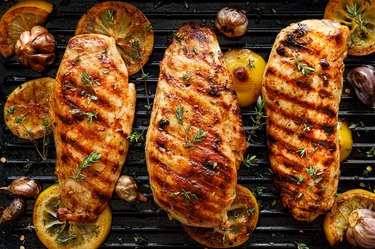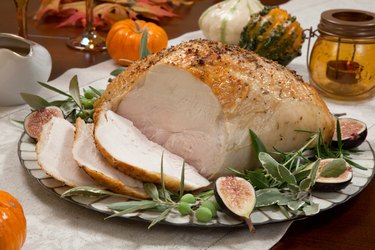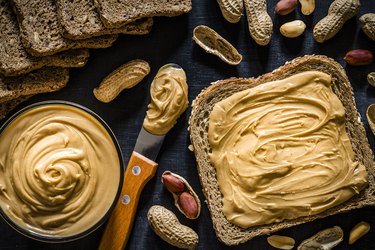We usually blame tryptophan for feeling sleepy after eating turkey on the holidays. But that's only part of the story.
Tryptophan, or L-tryptophan, is one of the nine essential amino acids — it's "essential" because your body can't make it on its own and needs to obtain from food. Amino acids are the building blocks for protein. Your body converts tryptophan to niacin, a B vitamin that plays a role in metabolism, per the U.S. National Library of Medicine (NLM).
Video of the Day
Video of the Day
Tryptophan also helps make the brain chemicals serotonin and melatonin. Melatonin regulates the circadian rhythm (or the sleep-wake cycle), and serotonin helps stabilize appetite, mood and sleep, according to a May 2018 analysis published in Nutrients.
So, that's part of the reason why tryptophan is associated with feeling so tired and sleepy after eating turkey. Still, other tryptophan-rich foods (like chicken, pork, salmon, tofu and legumes) might not have the same drowsy effect.
How Much Tryptophan Do You Need?
Adults should aim for 1.8 milligrams per pound of body weight (or 4 milligrams per kilogram of body weight), according to the World Health Organization (WHO) and the National Academies Press.
That means a person who weighs 154 pounds (or 70 kilograms) should get about 280 milligrams of tryptophan per day.
Check out the foods high in tryptophan below. Note that the Recommended Daily Intake (RDI) percentages below are based on eating 280 milligrams of tryptophan per day.
1. Chicken Breast: 687 mg, 245% Recommended Daily Intake (RDI)

Chicken breast is rich in protein, completely carb-free and low in fat. This lean protein also contains almost no saturated fat, which is a great bonus as the 2020-2025 Dietary Guidelines recommend limiting saturated fat to less than 10 percent of your daily calorie intake.
If you're wondering what food has the most tryptophan, it's chicken breast. A 6-ounce serving of cooked lean chicken breast packs 245 percent of the RDI for tryptophan, so if you want to get a headstart on your amino acid intake for the day, try these breakfast chicken recipes.
2. Lean Pork Chops: 627 mg, 224% RDI
Pork amounts to an estimated 36 percent of the overall meat intake globally, followed by chicken and beef, per the USDA.
Pork chops are an excellent source of tryptophan, providing 224 percent of the RDI in a 6-ounce cooked serving. Plus, this popular meat may benefit your health in other ways: Pork chops are rich in selenium (with 147 percent of the DV), which is important to help keep your thyroid functioning properly, per a December 2021 review in the journal Molecules. Selenium also acts as an antioxidant, protecting your body from oxidative damage, per the National Institutes of Health (NIH).
3. Firm Tofu: 592 mg, 212% RDI
Tofu is one of the top tryptophan-rich vegetarian foods. One cup of cooked firm tofu packs 212 percent of the RDI for tryptophan. In addition, this plant-based protein is high in fiber, calcium, B-vitamins and offers 43 grams of protein per serving. Try these flavor-packed, high-protein tofu recipes.
4. Sockeye Salmon: 570 mg, 203% RDI
Salmon happens to be one of the foods that have more tryptophan than turkey. Sockeye salmon provides 203 percent of the RDI for tryptophan per 6-ounce fillet (compared to turkey's 174 percent of the RDI). But that's not all that salmon offers.
Salmon is high in vitamin D, selenium, vitamin B6 and omega-3 fatty acids. Other cold-water fatty fish like herring, mackerel, sardines and tuna are also rich in these healthy fats. Omega-3s, especially DHA and EPA (the kind found in fatty fish), are tied to a reduced risk of some chronic conditions like heart disease, cancer and Alzheimer's disease, according to the NIH.
Try these healthy salmon recipes to get your fill of tryptophan and omega-3s.
5. Turkey Breast: 488 mg, 174% RDI

A list of foods high in l-tryptophan wouldn't be complete without the infamous turkey. Although surprisingly not the highest source of tryptophan, turkey is still rich in this amino acid. A 6-ounce serving of roasted turkey breast has 174 percent of the RDI for tryptophan.
Turkey is also high in selenium, phosphorus, zinc and vitamins B6 and B12. Try these leftover turkey recipes for dinner.
6. Edamame: 416 mg, 149% RDI
Green soybeans, or edamame, are a satiating plant-based protein thanks to their fiber and protein profile. They're also considered a complete protein because they contain all nine essential amino acids.
One cup of cooked edamame provides 149 percent of the RDI for tryptophan, 31 grams of protein and 37 percent of the DV for fiber. Edamame are very nutrient-rich and an excellent source of magnesium, copper, vitamin K and B vitamins like folate and thiamin.
7. Canned Tuna: 252 mg, 90% RDI
The recommendations for tuna are like a see-saw. On the one hand, canned tuna can be a nutritious and cost-effective protein option that offers many health benefits. But, on the other hand, tuna can be high in mercury and not as healthy as you think. So while you may not want to eat canned tuna every day to avoid mercury poisoning, it may be OK to eat once a week, per a November 2015 review published in Environmental Research.
One thing is for sure, though: Canned tuna is rich in l-tryptophan, providing 90 percent of the RDI for tryptophan per 3-ounce serving.
8. Milk: 211 mg, 75% RDI

Every day, it seems like more and more non-dairy milks are sprouting up at the grocery store. But cow's milk is still one of the best sources of tryptophan compared to other types of milk.
A 16-ounce glass of skim milk gives you 75 percent of the RDI for tryptophan and 16.5 grams of protein. Low-fat (2 percent) and whole milk aren't too different, providing 73 percent and 70 percent of the RDI for tryptophan per 16-ounce glass, respectively. If you have lactose intolerance, consider switching to lactose-free milk such as Lactaid to ease your tolerance.
9. Squash and Pumpkin Seeds: 162 mg, 58% RDI
Pumpkins are usually synonymous with fall, but pumpkin seeds, or pepitas, can be enjoyed year-round. These seeds pack quite the polyphenol, antioxidant and nutrient punch. Pumpkin seeds are linked with reducing the risk of certain conditions, inflammation and infection, depression, blood sugar and blood pressure, according to a November 2020 review published in Scientific African.
A 1-ounce serving of pumpkin seeds packs 58 percent of the RDI for tryptophan and 8.5 grams of protein. Try these easy roasted pumpkin seed recipes to transform the seeds into something special.
10. Oatmeal: 94 mg, 33% RDI
Oatmeal is a nutritious and affordable breakfast option to start your day. You can get 33 percent of the RDI for tryptophan in 1 cooked cup of oatmeal, as well as 5.9 grams of protein and 12 percent of the DV for fiber.
They are great for meal prep and can be prepared in advance (by making overnight oats, for example). Because of their mild flavor, oats are also versatile and can be mixed with anything, sweet or savory. Try these savory oat recipes that you can enjoy for breakfast, lunch or dinner.
11. Eggs: 77 mg, 27% RDI
For so long, people were afraid to eat eggs because they were told that the high amount of dietary cholesterol in eggs would raise their cholesterol levels. But many registered dietitians agree that eggs can be part of a healthy diet and actually offer many health benefits.
Eggs are a quick-to-prepare, easy and affordable high-quality protein option. One large hard-boiled egg provides 6.3 grams of protein and 27 percent of the RDI for tryptophan. In addition, eggs are high in lutein and zeaxanthin, antioxidants that are linked to reduced risk and progression of age-related macular degeneration and cataracts, according to a February 2017 review in the journal Nutrients.
Try these nutrient-packed egg recipes that you can enjoy any time of the day.
12. Peanut Butter: 74 mg, 26% RDI

If you're asking yourself if peanut butter is high in tryptophan, the answer is yes! Two tablespoons of peanut butter has 26 percent of the RDI.
Peanut butter is also a good source of plant sterols, vitamin E and monounsaturated fats, which provide heart-protective benefits. These nutrients help reduce inflammation, decrease plaque buildup in the arteries and lower LDL (bad) cholesterol and triglyceride levels, according to the Mayo Clinic. Try these filling peanut butter recipes (none of which are PB&J).
- NLM: "Tryptophan"
- Nutrients: "Dietary Neurotransmitters: A Narrative Review on Current Knowledge"
- World Health Organization: "Protein and amino acid requirements in human nutrition"
- The National Academies Press: "Dietary Reference Intakes for Energy, Carbohydrate, Fiber, Fat, Fatty Acids, Cholesterol, Protein, and Amino Acids"
- USDA: "Dietary Guidelines for Americans 2020-2025"
- USDA: "What is the most consumed meat in the world?"
- NIH: "Selenium"
- NIH: "Omega-3 Fatty Acids"
- Environmental Research: "Benefits and risks associated with consumption of raw, cooked, and canned tuna (Thunnus spp.) based on the bioaccessibility of selenium and methylmercury"
- Scientific African: "The potential of pumpkin seeds as a functional food ingredient: A review"
- Nutrients: “Lutein and Zeaxanthin—Food Sources, Bioavailability and Dietary Variety in Age-Related Macular Degeneration Protection”
- Mayo Clinic: "Nuts and your heart: Eating nuts for heart health"
- Molecules: "Selenium: An Element of Life Essential for Thyroid Function"